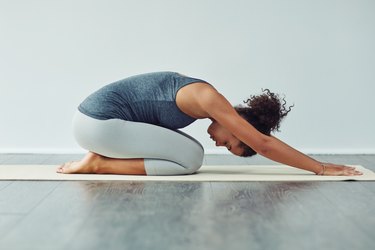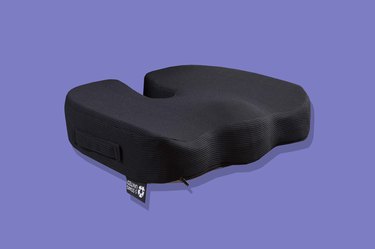
So you've finally decided to get serious about Grandma's advice to stand up straight? Smart move.
Poor posture can take a real toll on your body: It throws your spine out of whack, zaps your flexibility, sets the stage for injuries and even makes it harder to digest your food and take deep breaths, per the U.S. National Library of Medicine.
Video of the Day
Video of the Day
And if you're someone who deals with back pain (1 in 4 U.S. adults do), well, that hunch could be to blame.
"Poor pressure takes your vertebrae out of neutral alignment," says Theresa Marko, DPT, doctor of physical therapy and board-certified clinical specialist in orthopedics. "This puts added pressure on your lumbar and cervical spine, which can lead to joint stress."
Even worse? Having posture that's less than perfect now can set you up for bigger problems down the road. Namely, hyperkyphosis — extreme slouching that affects up to two-thirds of older adults, per a June 2010 study in Orthopedic & Sports Physical Therapy. This condition can affect your balance and make it harder to do even basic activities like brushing your hair or getting dressed.
In short, there are lots of good reasons to get serious about straightening up. Kicking the hunching habit can take some time, but with a little dedicated effort, it's possible. Here's how.
First, Know What You’re Working Toward
The hanging head, the rolled shoulders, the paunched out belly: It's easy to spot a sloucher, but if you've been doing it yourself for years, you might not know exactly what proper posture feels like.
Good posture means being in a position where your muscles and ligaments receive as little strain as possible and your spine maintains its natural curve, per the Cleveland Clinic. That means standing straight and tall with your shoulders pulled back, your stomach pulled in, and your head level to the ground, with your knees slightly bent and your feet hip-width apart.
There's a proper way to sit, too. Your legs should be uncrossed, with your ankles in front of your knees and your feet flat on the floor. Your shoulders should be relaxed, and your forearms should be parallel to the ground instead of tilted up or down, notes the American Chiropractic Association.
Reconfigure Your Set-Up
If you spend much of your day in front of a computer or at a desk, first, make sure your seating setup is pro-posture.
"Setting up an ergonomic workstation is critical because poor posture for prolonged periods of the day increases the risk for injury," says doctor of physical therapy John Gallucci, Jr., DPT.
For an ideal working environment, you'll want to pay attention to the following steps.
1. Adjust Your Seating
Your workstation chair should allow you to sit with your feet flat and your knees and hips positioned at 90-degree angles, Gallucci says. Invest in a footrest if your feet can't reach the floor.
Make sure, too, that your chair supports your lower back comfortably, recommends the Occupational Health and Safety Administration (OHSA). That means no stools or chairs with uncomfortable backs.
2. Get the Height Right
Your goal is to keep your hands, wrists and forearms parallel to the ground while you're typing, per Yale University Environmental Health & Safety. If your desk sits too high or low to make that happen naturally, adjusting your seating can help you get to the right level.
3. Consider a Monitor Stand
"Your computer screen should be at eye level," Gallucci says.
If that's not the case with your current setup, invest in a monitor stand to get the position right. Place it in line with your keyboard, ideally 15 to 30 inches from your eyes so you don't have to lean forward or back to focus.
4. Invest in a Floor Mat
Whether your job requires you to be on your feet or you've opted for a standing desk setup, floor mats can make standing for long hours more comfortable by reducing pressure on your joints, Marko says. And when you're more comfortable, you'll be less likely to hunch or slouch.
5. Tweak the Lighting
If you find yourself leaning forward to read the screen or papers, add another light or a brighter bulb so you can see clearly without having to hunch.
If the glare from your monitor is causing you to turn your head to see your screen, reposition the monitor away from the windows and tilt it down slightly.
6. Take Frequent Breaks
Even with an ideal posture-friendly setup, sitting for long hours can reduce your flexibility —and ultimately make it harder to stand or sit straight.
"Even with perfect posture, your knees and hips are still bent. Thus your hip flexors, hamstrings and calves are in a shortened position and can feel tight when you get up to walk," Marko says.
Experts generally recommend getting up to stretch your legs at least once an hour. (Set an alarm on your phone so you don't forget.)
Related Reading
Take Good Care of Your Body

Even when you're off the clock, staying in shape is a must for protecting and improving your range of motion, which helps you sit or stand without slouching or hunching. Strength and flexibility exercises go a long way here, but they're not the only things that make a difference.
Here's how you can ensure your body will naturally fight against the slouch.
1. Stretch Regularly
Less flexibility means more muscle tightness, which literally makes your muscles shorter and less able to move in all directions. Tight hips, for instance, can pull your upper body forward into a hunch, while tight chest muscles lead to shoulder slouch, per Harvard Health Publishing.
Focus on stretches that bring your knees to your chest, or ones that stretch your hamstrings, calves or shoulders, Gallucci recommends. "Light neck stretching — by bringing the ear to the shoulder — will help improve neck mobility and posture too," he says.
2. Focus on Core and Leg Strength
A weak core is a recipe for slouching and leaning.
"Core exercises are key to better posture and strength throughout your entire body," Gallucci says.
To strengthen your middle and make it easier to hold yourself up straight, he recommends doing 10 to 12 minutes of core exercises every day. Practice moves like planks, dead bugs and bridges.
3. Try Exercises That Promote Mindfulness
Activities like yoga and tai chi can boost your flexibility and strength, but those aren't the only benefits. These kinds of exercises also help to improve your overall body awareness, say the National Institutes of Health. This can encourage you to pay closer attention to your posture, so you notice when you need to make an adjustment.
4. Keep Your Weight in Check
A healthy weight makes it easier to maintain a good posture with minimal effort, especially while standing. "It's the best way to keep a proper posture and help prevent low back pain," Gallucci says.
That's because extra pounds tend to result in weaker cores.
"A bigger belly is going to pull your pelvis forward, causing you to arch your back," Marko says. "The added weight will make it harder for your abdominals to contract and stabilize your spine."
Related Reading
Take Good Care of Your Mental Health

There's a relationship between how you feel and how you hold yourself.
"Posture can greatly impact a person's emotional state and mental health," says psychiatrist Laura Dabney, MD.
When you're depressed, you might be more likely to lean in or hang your head, while anxiety can lead to shoulder scrunching, the NIH notes. On the other hand? "People who sit upright have been found to have better moods," Dr. Dabney notes.
Of course, improving your posture isn't a cure for depression or anxiety disorders, and faking a smile alone won't fix your slouching problem. But simply being aware that your mood can affect how you sit or stand could be enough to help you sit or stand a little straighter.
"Certainly, a temporary bad mood can be impacted by poor posture and vice versa," Dr. Dabney says.
Consider a Posture-Correcting Product
Plenty of products promise to help keep a hunch at bay, and while they might provide an assist, they're not cure-alls.
"Don't spend a lot of money for what your body's musculoskeletal system was made for," Gallucci says. "It's more important to let the muscles do the work than rely on an external device."
In other words? The best posture correctors remind you to stand or sit straight on your own, without actually holding you in a position. So steer clear of products like straps or shirts and opt for items like these instead:
1. 5 Stars United Seat Cushion Pillow for Office Chair

This ergonomic memory foam pillow supports your body's natural contours and distributes your weight evenly to take the pressure off of your tailbone, helping you sit up straight.
It's relatively inexpensive, lightweight and has racked up more than 6,000 stellar reviews on Amazon, so there's not much to lose by giving it a try.
The only real downside? Memory foam isn't super breathable, so there's a chance it could make you hot.
Buy it: Amazon; Price: $32.99
2. Lumo Body Tech Lumo Lift

The Lumo Lift is basically a small, wearable activity tracker. Because it's designed to be worn by your collarbone (it attaches to your shirt), it can sense whether your posture is going out of whack. Slouch or slump, and the device vibrates to remind you to straighten up.
Use the app to track your progress, plus review data on things like distance moved and calories burned.
Buy it: Amazon; Price: $29.97
3. KT Tape Pro Synthetic Kinesiology Therapeutic Sports Tape

Here's a hack that might help you stand tall: Marko recommends kinesiology tape in lieu of a formal posture corrector.
"While standing, have someone tape you in an 'X' shape on your back from your shoulders to your lower back," she says.
The tape won't actually hold you into place, but when you slouch, you'll feel enough of a tug to remind you to straighten up.
Buy it: Amazon; Price: $12.72
- Orthopedic & Sports Physical Therapy: "Age-Related Hyperkyphosis: Its Causes, Consequences, and Management"
- Harvard Health Publishing: "Why good posture matters"
- U.S. National Library of Medicine: "Guide to Good Posture"
- Yale Environmental Health & Safety: "How to Set Up Your Ergonomic Home Office"
- Occupational Safety and Health Administration: "Computer Workstation eTool"
- Cleveland Clinic: "Back Health and Posture"
- American Chiropractic Association: "Maintaining Good Posture"
Is this an emergency? If you are experiencing serious medical symptoms, please see the National Library of Medicine’s list of signs you need emergency medical attention or call 911.